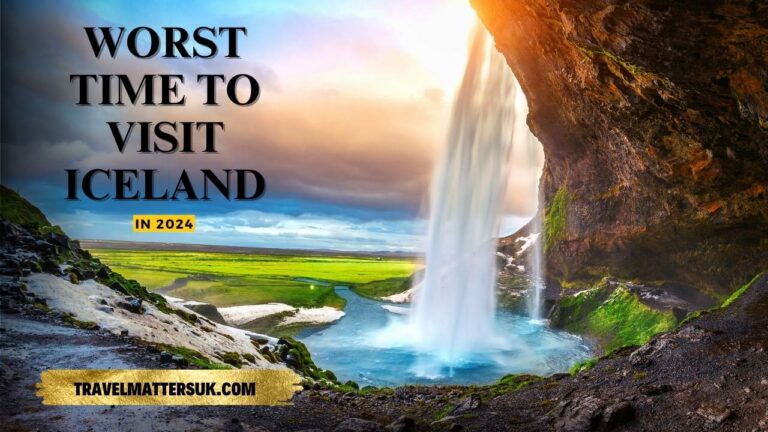Are you planning a trip to the breathtaking wilderness of Alaska? Before you pack your bags and embark on your Alaskan adventure, it’s crucial to understand that not all times of the year are created equal when it comes to visiting the Last Frontier. In this guide, we’ll explore the worst time to visit Alaska, ensuring you have all the information you need to plan your trip wisely.
When Is the Worst Time to Visit Alaska?
Alaska is a land of extremes, from its vast glaciers to its abundant wildlife. However, these extremes can make certain times of the year less than ideal for visitors. Let’s delve into the details of the worst times to visit Alaska:
1. The Dead of Winter (December to February)
If you’re not a fan of frigid temperatures and limited daylight, visiting Alaska in the dead of winter might not be your cup of tea. From December to February, the state experiences incredibly cold weather, with temperatures often dropping well below freezing.
Why It’s the Worst Time to Visit Alaska:
- Short Days: In the heart of winter, Alaska has very short daylight hours, sometimes as little as four to five hours of sunlight per day.
- Limited Activities: Many outdoor activities, like hiking and wildlife viewing, are challenging or impossible due to the harsh weather conditions.
- Inaccessible Areas: Some areas of Alaska are inaccessible during the winter months due to snow and ice, limiting your options for exploration.
2. Mud Season (April to May)
Alaska’s “mud season” occurs in the early spring when melting snow and rain create a muddy mess. This season can be particularly challenging for travelers.
Why It’s the Worst Time to visit Alaska:
- Muddy Trails: Hiking trails can be muddy and difficult to navigate, making outdoor adventures less enjoyable.
- Black Flies: Swarms of pesky black flies can be a nuisance for outdoor enthusiasts.
- Limited Wildlife: Many animals are still in hibernation or have not yet emerged, making wildlife sightings less likely.
3. Shoulder Seasons (September to October)
While fall in Alaska can be stunning with its vibrant foliage, it’s also a time of transition, and it comes with its own set of challenges.
Why It’s the Worst Time to visit Alaska:
- Changing Weather: Weather can be unpredictable, swinging from warm and sunny to cold and rainy within a short span.
- Fewer Activities: Some tour operators and lodges may start shutting down for the season, limiting your activity options.
- Reduced Daylight: As the days grow shorter, you’ll have less time for outdoor exploration.
The Most Asking Question About Alaska
Why Winter Is The Worst Time To Visit Alaska?
-
Extreme Winter Weather: Alaska’s winter is characterized by extremely cold and unpredictable weather. Temperatures can plummet well below freezing, reaching as low as -60°F (-51°C). This makes travel challenging and potentially dangerous.
-
Short Daylight Hours: Winter in Alaska sees shorter daylight hours, which means less time for outdoor activities and enjoying the natural beauty of the state.
-
High Tourist Season: Surprisingly, winter is the busiest time for tourism in Alaska. This results in more crowded and expensive accommodations and attractions. If you seek a quiet and relaxed vacation, winter might not be the ideal time.
-
Precautions for Winter Travel: Travelers visiting Alaska during winter need to be well-prepared. This includes dressing in layers to combat the cold, wearing proper boots for walking on snow and ice, and checking weather forecasts regularly. It’s also crucial to be prepared for potential emergencies, like carrying a first aid kit and notifying someone about your travel plans if you’re heading to remote areas.
-
Challenges of Winter Driving: Winter driving conditions in Alaska can be hazardous due to icy roads, poor visibility, and the possibility of encountering wildlife. Travelers should drive cautiously, carry tire chains and a shovel, and be aware of these challenges.
-
Business Closures: Many businesses and attractions in Alaska shut down during the winter months, so planning and booking tours and activities well in advance is essential.
-
Opportunities in Winter: Despite the challenges, winter in Alaska offers unique experiences like witnessing the Northern Lights and observing wildlife that is more active in the cold.
The Most Asked questions about a visit to Alaska
When Is the Best Time to Visit Alaska?
Now that we’ve covered the worst times to visit Alaska, let’s briefly touch on the best times. Generally, the months of June to August offer the most favorable conditions for travelers. During this period, you can enjoy milder weather, extended daylight hours, and a wide range of outdoor activities.
1. What is the Most Expensive Month to Go to Alaska?
Alaska’s peak tourist season generally falls during the summer months, particularly from mid-June to mid-September. During this period, you can expect higher prices for accommodations, tours, and activities. July, in particular, tends to be the most expensive month, as it offers the best weather for outdoor adventures and wildlife viewing.
2. What is the Best Month to See Alaska?
The best month to visit Alaska depends on your preferences. If you’re seeking warm and pleasant weather, June and July are prime months when temperatures range from the 60s to low 70s, making it ideal for outdoor activities and wildlife sightings. However, for those interested in viewing the Northern Lights, the best time is during the winter months, from late September to early April.
3. What are the Cheapest Months to Go to Alaska?
The shoulder seasons of May, early June, and mid-September to early October offer more budget-friendly options for travelers. During these months, you can often find lower rates for accommodations, tours, and excursions. While May and September provide milder weather and fewer crowds, early October can be chillier but offers unique fall colors and northern lights viewing.
4. Is October a Worst Time to Visit Alaska?
October can be a mixed bag in Alaska. It’s considered part of the shoulder season, which means lower prices and fewer tourists, but it also brings colder temperatures and shorter daylight hours. Whether October is a good time for your visit depends on your interests and tolerance for cooler weather.
5. Is Alaska Snowy in October?
Yes, Alaska can see snowfall in October, especially in the northern and interior regions. Snowfall can vary widely depending on your specific location within the state. Coastal areas may experience milder temperatures and less snow, while inland areas can see accumulating snowfall.
6. How Cold is Alaska in October?
Alaska’s temperatures in October can vary but generally range from the 20s to 40s Fahrenheit (-6°C to 4°C). Keep in mind that temperatures can drop significantly in the evenings and overnight, so it’s essential to pack accordingly with warm clothing.
7. Is it Light in Alaska in October?
Alaska experiences decreasing daylight hours in October as it transitions into winter. However, the exact amount of daylight depends on your location within the state. In some parts of Alaska, particularly northern regions, you may experience shorter days with less sunlight.
8. What is the Coldest Month in Alaska?
The coldest month in Alaska is typically January. During this month, temperatures across the state can drop significantly, with many areas experiencing sub-zero temperatures. This is when Alaska truly lives up to its reputation for extreme cold.
9. Can I See the Northern Lights in Alaska in October?
Yes, it is possible to see the Northern Lights in Alaska in October, especially as the month progresses and the nights get longer. The northern lights, or auroras, become more active as winter approaches. To increase your chances of witnessing this natural spectacle, head to a location with minimal light pollution and clear skies, and monitor aurora forecasts for optimal viewing opportunities.
These points provide valuable information for travelers considering a visit to Alaska during different times of the year, helping them plan their trips according to their interests and budget.
Planning Your Alaska Adventure
Before booking your trip to Alaska, consider what experiences you’re seeking. If you’re after long hikes, abundant wildlife, and pleasant weather, aim for the summer months. However, if you’re intrigued by the magic of winter landscapes and don’t mind the cold, a visit during the shoulder seasons might be just what you’re looking for.
Remember, every season in Alaska has its unique charm, but it’s essential to align your travel dates with your interests and tolerance for extreme conditions. With the right preparation and expectations, Alaska can be an awe-inspiring destination year-round.
In conclusion, Alaska’s beauty is unparalleled, but it’s vital to choose the right time for your visit. By avoiding the worst times to visit Alaska and planning your trip accordingly, you’ll ensure a memorable and enjoyable adventure in this magnificent state. Keep Visiting Travel Matters






